How to ID Fish on ANY Flasher (Without a Camera)

By Joel Nelson
Of paramount importance to any hobby is knowing what you're working with.
Just like a golfer doesn't take a shot without knowing wind
speed/direction, distance to the green, or pin location, you'll probably
do a whole lot better at this ice-fishing thing if you know what
species just showed up on your sonar.
Each species has differing biology, behaviors, and ultimately,
bite-triggers, making the game much easier to play when you're armed
with species by species knowledge. While Fish ID is not a novel concept
from the ice-electronics end of the world, the best any graph has
mustered to-date is simply showing marks as small, medium, or large
fish, often in varying degree or fashion depending on a number of
factors.
Underwater cameras are another way to get after fish speciation, but
what if you don't own one, you're hole-hopping, or you're dealing with
camera-shy fish?
Enter Tony Roach, a man who has seen just about everything that swims
on a host of ice-fishing electronics units. "That's a walleye," he
confidently announced as we were jigging up bluegills recently. "See it
belly-to-bottom, then come up, then drop down. It's done it about three
times in the past 30 seconds."
Eventually, Tony connects, bringing a particularly golden 'eye up on a
panfish jig of all things. How did he know it was a walleye, when we
had landed nothing but 'gills the prior 10 hours on ice? More
importantly, what are the tell-tale signs, species by species, that will
help us determine what we're fishing for, and ultimately what bait to
present and how?
Let's answer some of those questions.
First and foremost, there's no substitute for seeing multiple
varieties of fish in a host of depths, structure, and cover to help you
accurately ID a sonar mark once you see it. These are generalities, made
to help you start looking for cues to tip you off to fish species, such
that you can present the right bait, the right way to them. That said,
there's a few guides you can use to get started.
If your sonar is worth a darn, big marks are big fish, small marks,
often denoted by colors other than dark red, are small fish. If small
fish look big, and big fish look the same size, it's time for a sonar
upgrade.
Use zoom mode if you can for the depth and application you're fishing
to get the most resolution from your flasher possible. This is
especially important for fish that hang on or near bottom like walleyes.
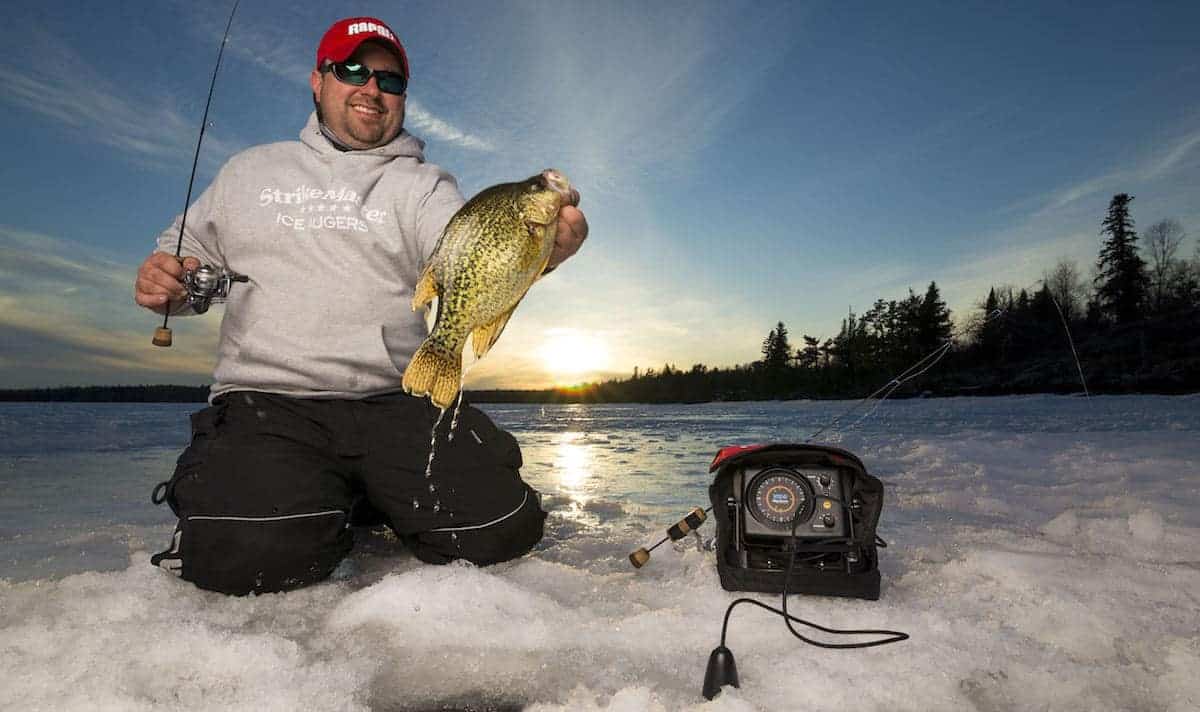
Crappies
Crappie targets are often a function of the depth you're fishing, and
move slowly and methodically, usually in large schools suspended over
deeper water. This is where an adjustable zoom mode, that increases
target separation and precision anywhere in the water column, comes in
especially handy.
"Those things grow bigger and smaller on the Marcum as they mill
around down there," Tony notes, "and they usually show up at the same
level as the bait or just below if the screen was previously clear of
fish."
Usually, schools are segregated, so large marks will mean large crappies for most natural lakes.
"Some days, bigger fish in the school feed above the rest, but more
often you've got to punch down and past those smaller more aggressive
crappies to get to larger fish. The best part, is that the marks don't
lie. Big marks, are big fish," says Tony.

Bluegills
Bluegills, to me, are probably the easiest, especially bull gills.
They tend to emerge on your sonar near bottom, and will almost always
slowly rise to your bait, stopping mere inches away to study it, making
you guess the entire time whether or not they sucked in your offering,
or are still staring it down. If you swing and miss, they're gone,
rarely if ever to return. Even if they charge the bait and are extremely
aggressive, they'll almost always still study the bait longer than most
species will.
Smaller versions of the species do look small on sonar, whereas bull
gills can be mistaken for bass or larger predators if studying just the
size of the mark alone. Either way, jigging too aggressively, especially
as the fish closes can also get them to leave quickly.

Bass
Speaking of bass, they typically show up at the same level as your
lure, making the mark from your bait "grow" exponentially in size. Their
attitude in winter is often ho-hum, so think bull gill mark, only
larger.
As a bass inhales the bait, the bite is slow, soft, and causes the
rod tip to generally sink a good deal. Seconds in, you'll know what
you're dealing with, and can adjust for additional fish that look and
act the same way throughout the day.
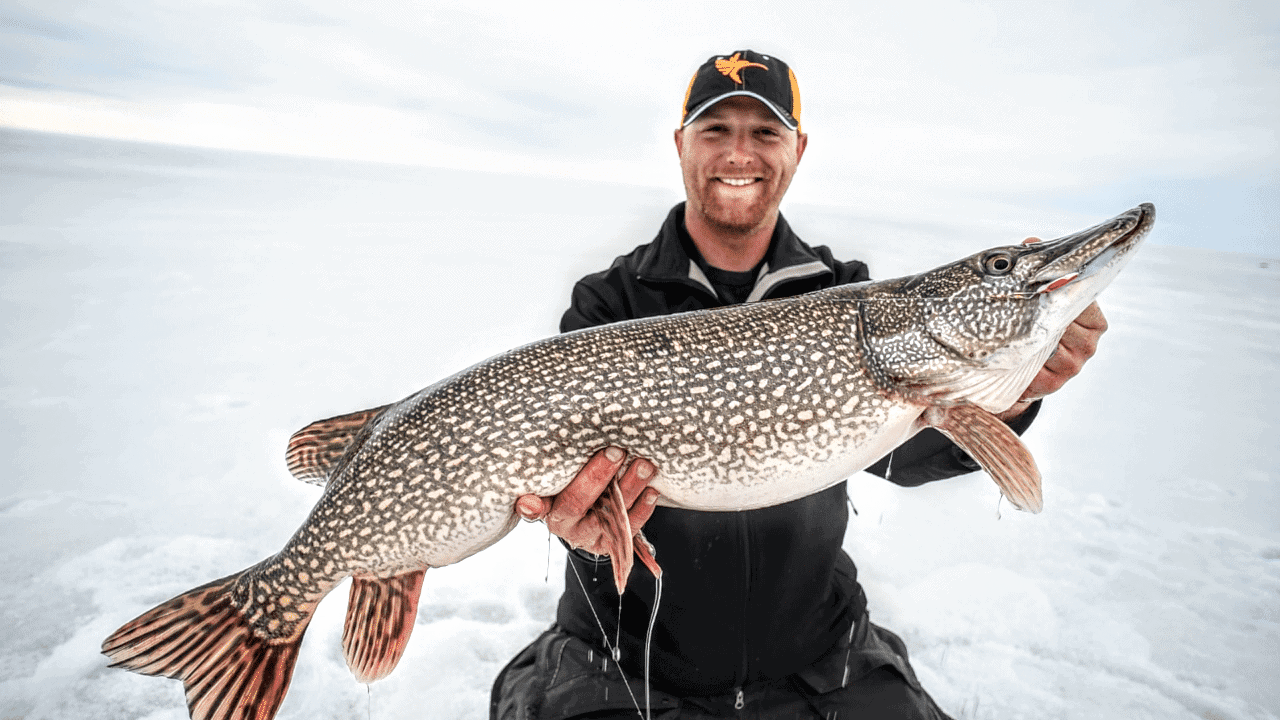
Pike
Pike show up where they please, and are often very large marks due to
their length. Especially a large mark that appears well above your
bait, anywhere in the water column, tends to be a pike in most
Midwestern waters. This is doubly true when reactions are swift, with
the target being large and red one second, and gone the next.
In shallower water, say under 10 feet, they can come in so fast that
you barely have time to see and/or react to any strike. Expect them to
do the unexpected, and have your drag set!

Walleyes
Walleyes are another easy one, often showing up connected to bottom
and appearing as if it just got ever so slightly shallower. Roach, a
particularly astute walleye angler mentions, "Eventually, that mark
separates from bottom to come up to your jig, and either hits, or does
not."
The retreat and re-appear here are key to species identification
here, as walleyes very typically do the "yo-yo", up and down trick a few
times before committing and hitting unless they're very aggressive.
Dropping the bait into bottom, playing keep-away, and generally being a bit more aggressive with your jigging stroke can be effective ways to catch them once you know what you're dealing with. Use these clues and continually question what you're seeing. Make note of even the slightest observations, compare with an underwater camera if available, and convert those fish behaviors onscreen into actionable intelligence that you can use to entice more of their kind to the top of the ice.
Top Ice Fishing Lures You Need to Try
By In-Fisherman
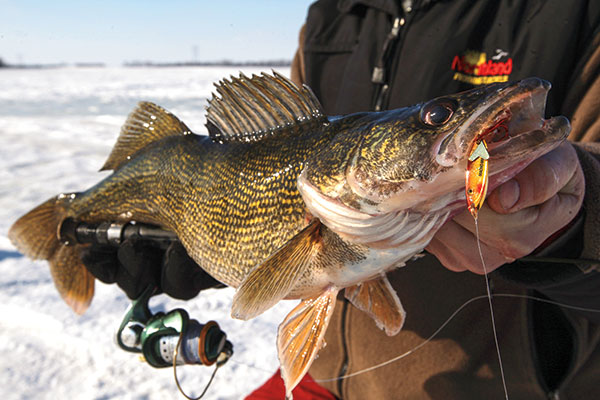
In last year's Ice Fishing Guide, In-Fisherman Editor In Chief Doug Stange picked his Top 10 Ice Lures of All Time. He focused on lures for larger predatory fish: walleyes, pike, bass, lake trout. His choices were (in no particular order of preference) the Acme Kastmaster, Custom Jigs & Spins Slender Spoon, Jig-A-Whopper Rocker Minnow, Northland Forage Minnow, PK Flutter Fish & PK Spoon, Nils USA Hali, Williams Nipigon, Rapala Jigging Rap, Nils Master Jigging Shad, and Livetarget Golden Shiner. That's actually 11 top choices, but he included the two PK items together as one.
We asked three noteworthy members of the ice community to make their choices. Cory Schmidt has been writing about ice fishing for decades and is a longtime In-Fisherman field editor. Tom Gruenwald also is a longtime writer on ice topics and a TV host, who has for many years worked in various capacities with HT Enterprises, a well-known ice-industry company. Jason Mitchell also is a well-known writer and TV host, who has been instrumental in designing ice equipment. Their picks are offered in no particular order.
Cory Schmidt's Top Ten
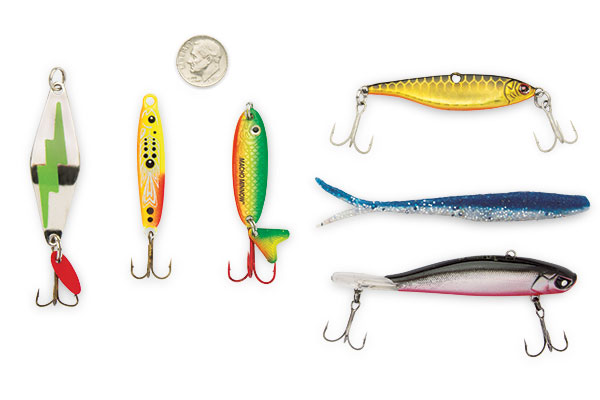
Sebile Vibrato—I love the horizontal posture and vibration. It's an overlooked option in most ice locales.
Rapala Jigging Rap—The #7 and #9 are big-fish hero lures.
Bay de Noc Lures Do-Jigger—My favorite flutter-style spoon of all time gives off subtle, baitfish-like flashes on the upstroke and has a beautiful shimmy on the fall.
Salmo Chubby Darter—In-Fisherman Digital Editor Jeff Simpson's creation is the best predator "fish call" ever made.
Custom Jigs & Spins Slender Spoon—Another exceptional light flutterspoon.
Northland Tackle Macho Minnow—Catches pressured fish like few other spoons.
Reel Bait Flasher Jig—I love this jig in dark water, tipped with a lively fathead or shiner, worked within a foot of the bottom. Works deadsticked on or near bottom, as well.
PK Lures Flutter Fish—Every time I fish this spoon, I wonder why I don't fish it more. Always catches fish.
Jig-A-Whopper Lazer Rocker Minnow—First offered by Gary Snyder's Jig-A-Whopper brand, HT Enterprises now markets this aggressive-working spoon—another all-time great.
Lucky John Maiko—After one season, I think this one could become another classic. It's a swimming minnow with a wobbling action you have to see to believe. A great fish caller, and they eat the heck out of it when they get there.
Schmidt: "There's something satisfying about still being able to tie on the same magical silver-blue Do-Jigger I used 25 years ago to catch walleyes. And even after all this time, walleyes in most icy environs still also react aggressively to a #7 Jigging Rap. Indeed, last winter, I broke out an old orange-and-gold foil pattern Jigging Rap I purchased from Dave Cook's Sporting Goods in Denver, Colorado, around 1979, and caught my biggest walleye of the season.
"My wish for new entries in the swimming lure category were granted this year. As I held Berkley's Snap Jig in my hand, even in the heat of Orlando's July 2017 ICAST show, my mind immediately pined for first ice. It has a tail resembling the Jigging Rap, giving it a wide gliding action. It also has a barbed keeper for rigging with your favorite softbait. Small flukes come to mind. Z-Man's Slim SwimZ has been a recent favorite. The new Berkley PowerBait MaxScent Flat Nose Minnow is another good option. This, along with some of the new walleye-sized tungsten jigs, such as Fiskas XL Walleye Jig, give anglers hope that good things are happening on the ice lure scene. And yet, we know our favorite old Do-Jiggers, Swedish Pimples, Rocker Minnows, and Kastmasters can just as easily emerge from the box when a fish needs catching."
Tom Gruenwald's Top Ten
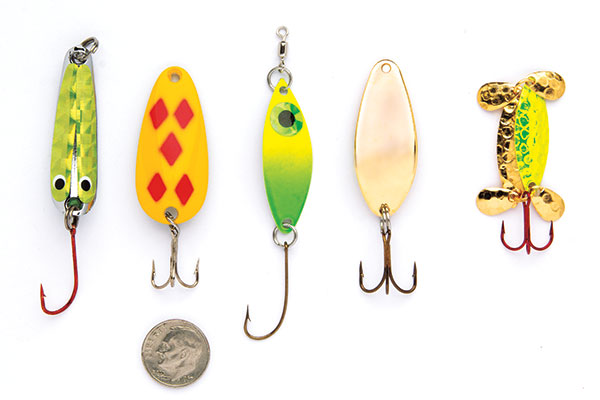
Acme Little Cleo—The erratic action generated by this little dynamo makes it versatile, a powerful flurry of attraction and strike production.
Jig-A-Whopper Lazer Rocker Minnow—This original Jig-A-Whopper design, especially when tipped with an action softbait, has been remarkably consistent for tempting fish.
Nils Master Jigging Shad—This little powerhouse closely resembles a plethora of natural forage. It has a beautiful glide that draws fish in and makes them bite
Bait Rigs Willow Spoon—With a hop and a fall on slack line, this one flips broadside and flutters, a terrific option when fishing shallow, over thick cover, or attempting to trigger tentative fish.
Snyder Lures Big Shaker—Whether aggressively ripped or gently quivered, this double-bladed, dimpled gadget with secondary fins creates a loose, fluttering mass of flash and vibration.
Rapala Jigging Rap—Perhaps the single best ice fishing lure of all time—a classic.
Jig-A-Whopper Hawger Rattle Spoon—Especially good in stained water and low-light conditions. The slightest wiggle generates strike-agitating commotion.
PK Lures Flutter Fish—Flashing, flickering, rocking, it's a winner that emulates dying baitfish to perfection.
Bill Lewis Rattle Trap—Not considered an ice fishing lure by most, this noisy, high-profile crank works wonders at times.
Len Thompson Five O' Diamonds—Somehow, even when nothing else seems to be doing well, this little gem produces action.
Jason Mitchell's Top Ten
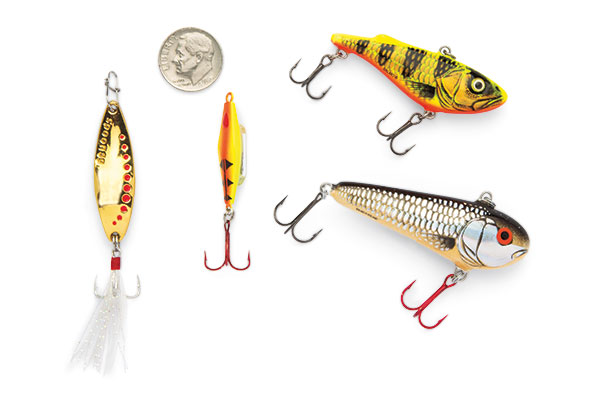
Rapala Jigging Rap—It's hard to disagree with so many who observe that this might be the best ice lure of all time. The Northland Puppet Minnow also deserves mention among this class of lures.
Clam Leech Flutter Spoon—My go-to spoon the last year, especially for walleyes, but it's also a fireball for trout, perch, and crappies.
Acme Kastmaster—An angler could tie one on a rod and never take it off the season long.
Northland Tackle Buck-Shot Rattle Spoon—The same with this classic fish-producer.
Clam Rattlin' Blade Spoon—Tinkle-tinkle, flash and dash, attracts fish and gets them to bite big time, especially active fish. Sports the loudest rattle that barely requires any movement.
Salmo Chubby Darter—This silent wobbler rides beautifully on a horizontal plane. It's my choice in so many situation for big walleyes, pike, and lake trout.
Livetarget Golden Shiner—The one that started it all, or at least revitalized the use of lipless lures for big walleyes and lake trout.
Salmo Zipper—Another sweet lipless option. It was the smallest size (#5) that helped bring the lipless craze back into focus for me.
Bay de Noc Swedish Pimple—Perhaps the best spoon design of all time, having stood the test of time for more than 50 years.
Clam Blade Spoon—Gets the call when I'm looking for a silent spoon that fishes subtly. Produces a deadly treble-hook bounce on a tight quiver.
Locating Big Channel Cats Under Ice
By Steve Ryan

Channel catfish are one of the more peculiar species to target through the ice. They're available in most ponds, lakes, and rivers across the ice belt. They grow big, fight hard, and taste great. Yet, only a small fraction of ice anglers pursue them. Since knowledgeable anglers have long ago debunked the myth that channel catfish hibernate in winter, and discovered that standard walleye gear can be used to catch them, locating active channel catfish appears to be the biggest challenge for anglers. That's easily solved by following a few locational tips.
River/Chain-of-Lakes SYSTEMS
Matt Johnson, a professional angler and Minnesota guide, recognizes the dynamics that channel catfish add to the ice season. When lakes enter their midwinter doldrums or his customers want a break from the usual mix of panfish and walleye, Johnson confidently puts them on some unforgettable hard-fighting catfish action.
He suggests focusing on lakes fed by river systems that are known catfish producers during the open-water season. Although he has access to local rivers with prolific catfish populations, he cautions that rivers present quickly changing ice conditions. He avoids main river channel areas when guiding customers and concentrates on lake systems with less current and safer ice.
"While rivers hold concentrated schools of feeding catfish, you need to always keep safety a priority, and a chain-of-lakes system offers more stable ice conditions," he says. "Catfish location varies among fisheries, but deep water always plays a role, especially near current or the river channel."
Deep is a relative term. In shallower waters, a small depression with a maximum depth of 10 to 12 feet can attract a large portion of the lake's catfish population. In other fisheries that offer a considerable amount of water greater than 40 feet deep, the most productive spots may be far removed from the lake's deepest waters. Instead, Johnson advises anglers to target catfish along the first break into deep water that is slightly removed from current areas. "These fish seem more active and continue to cycle throughout the area, more so than in the middle of the deep basin," he says. "I want catfish moving. Moving fish are active fish. Fish that stage over deeper areas and hunker to the bottom are less likely to bite.
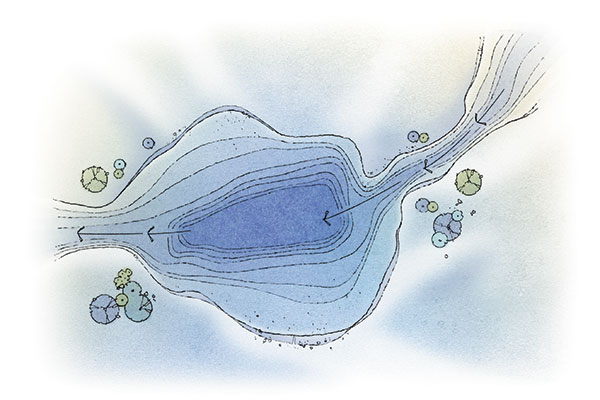
"This first break in depth or deep pool adjacent to current oftentimes holds the largest schools of catfish. Focus on suspended fish. This indicates an active school. If I'm not marking fish with some space between them and the bottom, I continue searching. Do giants hold tight to the bottom? Absolutely. But when looking for an active school of biters, I look for fish that are at least a few feet off bottom or suspended higher."
Johnson says catfish remain more active than other species like largemouth bass and walleyes during post-frontal periods. "It's amazing how much catfish act like other gamefish," he says. "Most anglers think they sit on the bottom and do nothing. On the contrary, they're actively feeding. They chase and eat live minnows and other fish. They don't just eat gunk off the bottom of the lake." For this reason, he targets suspended catfish, noting that most suspended fish are located in the bottom third of the water column. These fish are much easier to coax into biting than a fish with its belly on the bottom.
A 1/16-ounce Clam Leech Flutter spoon or the 1/8-ounce Clam Jason Mitchell Rattlin' Blade Spoon are two of Johnson's favorites, fished on 6- to 8-pound monofilament. "I tip these spoons with one or more minnow heads for scent. Several larger panfish offerings get the job done as well, like the larger Clam Pro Tackle Drop-Kick and Snow Drop XL jigs packed with maggots. Otherwise, a piece of cut sucker on a circle hook set inches off the bottom on a Jason Mitchell Meatstick Rod is works great."
Natural Lakes
In natural lakes not connected to large river systems, depth continues to play a key role in locating channel cats. Deep water provides steady temperatures, visibility, and adequate oxygen. Catfish seek these stable conditions. As supported by scientific tracking studies, catfish return to their same wintering areas year after year, provided that conditions remain favorable and fishing pressure doesn't become excessive. This makes it easier to locate key deep-water holding areas. Homework is reduced in subsequent years to simply pinpointing locations holding the highest concentrations of active fish.
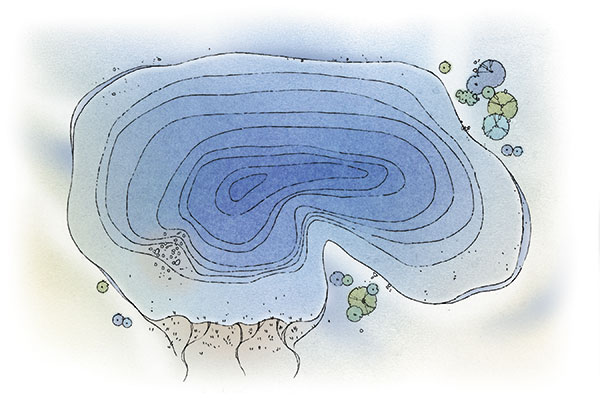
Since deep water remains relative from lake to lake, steep-breaking areas that drop into the main-lake basin should be examined first. This might be a break from 10 to 15 feet in moderately shallow lakes. In lakes with a substantial portion of water deeper than 25 feet, the key contour might be in the 15- to 20-foot range. On deep-basin lakes, eliminate expansive flat areas more than 40 feet deep. Such areas tend not to concentrate feeding catfish and create a "finding a needle in the haystack" situation.
With the key depth contour identified, target areas where the contour breaks quickly adjacent to a large vegetated flat. The best flats often have feeder creeks or major seepage areas that offer added oxygen and food throughout winter. Abrupt changes in contours that form underwater humps and points also are attractive. These areas offer anglers a focal area from which to cover multiple depths.
As with other gamefish, catfish use depth contours and structural elements like highways and road markers. They spend much of their resting time at the base of these contours and the flats formed by them. Channel catfish also have a strong preference for soft-bottom areas free of significant vegetation. This means eliminating hard rock bottom areas and those with dense weedgrowth. Prime spots include soft bottom areas from which bloodworms and insect larvae emerge.
Locating catfish wintering areas doesn't equate to "shooting fish in a barrel." Although key areas draw large aggregations of fish, channel cats are quite active at times, with a daily range that can span several hundred yards. Tip-ups and automatic devices spread out over large areas are great tools for locating and tracking their movement.
During low-light periods, it's not uncommon to catch large catfish on weedflats using lively golden shiners set a foot above the top of the vegetation. Catfish then transition to the outside weededge during the early morning hours prior to proceeding to the base of the deep break. Here they spend most of the day feeding in spurts. During periods of extreme high pressure, fish may slip deeper into the basin and position themselves tighter to the bottom.
Under normal conditions, a small percentage of fish in an aggregation rest almost motionlessly on the bottom. Most slowly cruise and feed within a few feet of the bottom in packs. Still others swim more quickly well off bottom or even suspend middepth in the water column. Watch your electronics and don't assume that high, quickly moving flashes aren't catfish. A good underwater camera is vital for distinguishing catfish from other species and for observing their mood.
Ponds
Catfish location in ponds depends on the type and construction of the pond. A few different types of ponds are worth examining. In many parts of the country, small impoundments are created by building an earthen dam across a creek. A spillway overflow pipe in the earthen dam regulates water level. Catfish are primarily located in the part of the pond nearest the dam. They often concentrate in the deep corners adjacent to the dam or at the next structural element closest to the dam and creek bed.
In ponds that are dug rather than dammed, catfish again look for deep water. Using an underwater camera, I've seen aggregations of catfish in many dug ponds. Good areas consistently have an uneven bottom free of dense vegetation. They tend to favor areas with some form of cover—a single tree trunk, discarded tires, or barrels that serve as a focal element. Finding these spot-on-the-spot locations can be difficult with only a flasher.
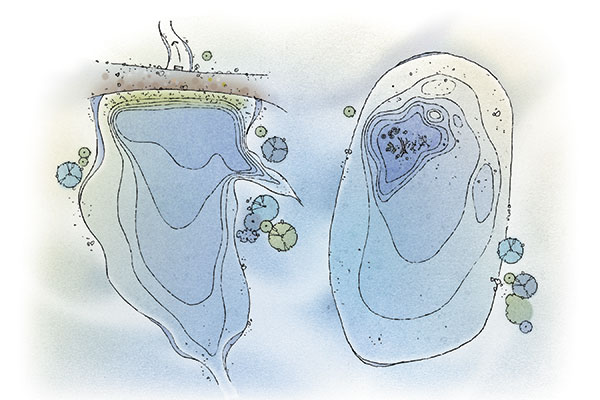
At times, 20 or more catfish can be concentrated in an area less than 6 feet in diameter. The smaller the pond or lake, the tighter catfish tend to congregate. A good underwater camera and precision in drilling holes are critical. Small compact cameras like the Aqua-Vu 5.0 Revolution Pro can be the difference between a slow day and a banner day. Previously, anglers may have failed to fully explore areas and find spot-on-the-spot locations due to dealing with older bulkier underwater cameras.
Today's compact cameras fit easily into bib pockets. The Aqua-Vu 5.0 Revolution Pro weighs mere ounces with its internal rechargeable lithium-ion battery and has a built-in cable reel on the back of the unit to retrieve and store the camera cable when hole-hopping or packing up for the day. No more hassling with an unmanageable camera cord. Since being off the mark by just 5 to 10 feet can make a big difference in catching winter channel catfish, the convenience of these new compact cameras can be a game changer.
Whether targeted in ponds, lakes, or river-fed chain-of-lake systems, locating favorable deep-water areas and then pinpointing distinctive structural elements are the first steps to catching winter channel cats. Once you find them, the real fun begins with these light-biting yet hard-fighting fish.
*In-Fisherman Field Editor Steve Ryan is an avid multispecies angler. He's appeared on In-Fisherman Television ice fishing for channel cats and has written extensively on the topic.
Ice Tactics for Bulging Brown Trout
By Matt Straw
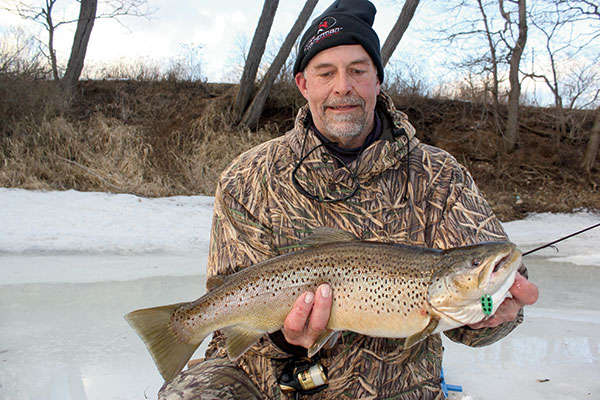
Walking on a frozen river is something I ordinarily won't do. But I've been known to follow "cheese-head" friends out on farm-country rivers in Wisconsin. "Follow" is the operant word, and only when the targets are brown trout the size of basset hounds.
So I show up a little late, after all the holes were drilled by Kerry Paulson, inventor and owner of Automatic Fisherman. Paulson likes to hunt browns everywhere, but this day we were on a river. "Even in slow rivers, browns look for current breaks under the ice," Paulson says. "Deeper water has to be nearby, but active browns often use areas only 3 to 4 feet deep, sometimes even shallower. They hang in the tailouts of pools where they find a current void under the flow running overhead."
Location
Location is about finding the least current over the right substrates. "Huge brown trout come out of Lake Michigan in fall and many stay in the river all winter," he says. "In Milwaukee Harbor, some people say browns like structure, some say they like flats. But it's a different game in harbors and lakes. In rivers, steelhead hold around rocks while browns prefer a softer bottom. Look along the shore.
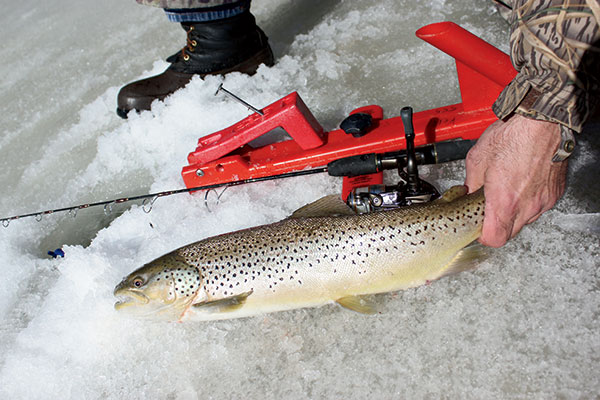
"Rocky shorelines predict steel; grass and sand predict browns. They travel that corridor more. Big ones hold on bottom more than steelhead, so I fish 2 to 6 inches off bottom. For steelhead, we set baits halfway down. Browns are lazier. Steelhead hang on the edge of the current or on the outside of a bend. Browns often hold on shallower inside bends, on sand- or mudflats next to the edge of the ice in one foot of water at times—literally a foot or two from the bank—often just downstream of a creek, spring, or freshet."
Rigging Up
I like a #6 Owner Mosquito Hook with no weight on the line in slack water and lakes, but a 1/64- to 1/32-ounce TC Tackle or VooDoo Custom Jig anchors a spawn bag, piece of shrimp, or several waxworms in current. I prefer 6-pound Seaguar AbrazX Fluorocarbon, but Paulson wants more stretch. "I like 6-pound mono," Paulson says. "I've caught monsters with 6-pound Trilene XL; friends have taken browns up to 29 pounds with it."
Spawn is the most consistent bait for Paulson. "Hardcore anglers favor brown trout, coho, or salmon spawn from early ice through midwinter because that's what browns feed on after those species spawn," he says. "I primarily use steelhead spawn and it works all winter. I think the key is fresh bait, not eggs from specific species. Shrimp is something a lot of people overlook. But some experts don't leave the house without it. And what we call Play-Doh—Berkley Gulp! dough in jars rolled into balls—catches everything. But when you harvest a ripe female steelhead from a put-and-take fishery and tie spawn bags with that, it catches browns anywhere."
Tactics
In shallow water, browns know when you're overhead no matter how quiet you are. So we stand or sit well away from a trap line of Automatic Fishermans placed in key spots. When fish bite, the rod tip snaps up and the arm it was supporting clacks down on the frame. If the drag is set right, you can reach the rod before the fish topples the rig. "Stand where you don't want the fish to travel," Paulson advises. "Stand, walk or sit well away from the holes. Light coming down the holes is a huge factor. Use hole covers or snow to block light. It's especially important on Lake Superior during the middle of the day."
Paulson has fished the Apostle Islands area of Superior many times with Guide Aron Kastern (Unlimited Trophy Outfitters, Mason, Wisconsin). "Brown trout fishing is the bulk of our winter business," Kastern says. "We have two types of browns. German and Scottish strains run up rivers in fall to spawn and then funnel back out. Some winter in the streams, some along shorelines under the ice. In the lake, Seeforellens and St. Croix strains can be around wood in 4 feet of water or out suspended over depths of 100 feet. At first ice, usually around Christmas time, we look for browns on structure. They might be on the first break down to 8 or 10 feet of water or on the second break down to 30, 40, or even 50 feet along a shipping channel or typical steep Superior shoreline."
River mouths can be key, but Kastern avoids community holes. Beyond that, likely-looking habitat stretches for miles. The intersection of rocky breaks and softer flats is a key location. "Finding them is tricky," he says. "We look for spots where rocky structure comes close to soft-bottom flats. Browns are versatile feeders. They root out crayfish and take sculpins off bottom, yet sometimes they suspend under lake herring over deep water. Looking down the hole, you see them come through in pairs or groups right under the ice at times. They're all over the place, so we set pretty high for them in clear water. If they're hungry and close to the bottom, browns come zipping up to bite."
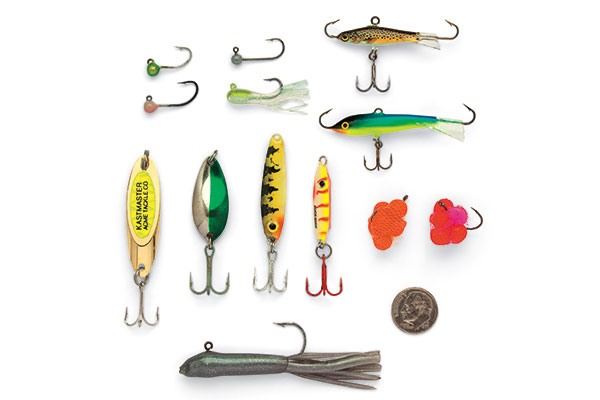
Cold as she is, Superior grows stupendous browns. "The average fish is 20 to 24 inches," Kastern says. "But we don't get too excited until they get up to 30 inches. A 34-incher is a great fish on a short rod. We use the Automatic Fishermans with 8-pound test because you have no idea what size fish you hook. We sometimes walk around hole-to-hole and jig, but we always have some tip-ups or Automatic Fishermans set. When fishing shallow, you have to keep quiet. Set lines out and sit down. It's typical to find them in 8 to 10 feet, and they're spooky at those depths."
Kastern's clients catch browns on Acme Little Cleos and Kastmasters from 1/8 to 1/2 ounce, depending on depth. "Jigging Raps, marabou jigs—browns can be taken on a variety of lures," he says. "If they're shallow on a bug bite, we catch them on spawn bags and light line. Sometimes we pursue them in 50 feet of water with lipless cranks—whatever efficiently covers the necessary depths. All these tactics appeal to incidental steelhead, splake, and cohos, too. Last year was a really good year. Every year seems to be getting a little better."
It seems that brown trout in inland lakes and reservoirs behave in similar fashion. Robby Richardson, an Eagle Claw pro-staffer in Colorado, fishes Blue Mesa Reservoir, one of Colorado's largest waters. "It has a healthy population of brown trout and ice fishing is one of my favorite ways to target them," he says. "Average fish are 1 to 2 pounds with a decent number in the 3- to 4-pound range. Occasionally we ice a 10-pounder. The key to consistently finding browns in Blue Mesa is finding food adjacent to rock structure of some sort, whether a sunken island or a riprap shoreline. Current from a nearby inlet is a plus. Depth varies through the season from 10 to 60 feet. Low-light periods are typically best, but we typically find browns moving up to feed all day long."
Huge lakers also inhabit Blue Mesa. "To be prepared for anything, I fish a medium-power rod in the 28- to 32-inch range for most presentations," he says. "I'm a fan of Wright & McGill Tony Roach ice rods because the bite can be extremely light. I use a 500- to 1000-size Shimano Sedona reel with 10-pound PowerPro or 6-pound Yo-Zuri Hybrid line, depending on the temperature and whether I'll be fishing outside or inside. I use 6-pound P-Line Fluorocarbon leaders with braided mainline because browns are spooky and have great vision."
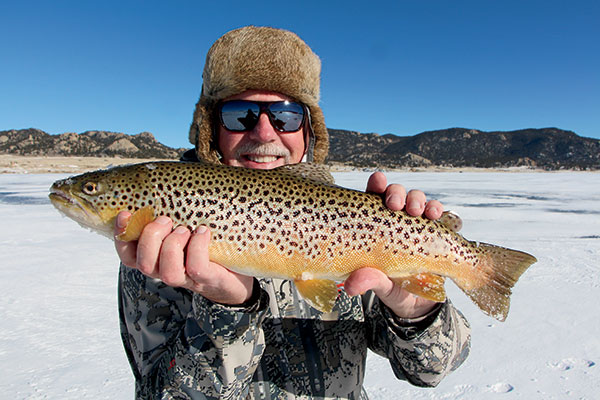
Richardson catches browns with a variety of techniques. "Two of the most productive are jigging spoons or jigging and deadsticking with plastics," he says. "My favorites are the DX Lures Flutter Spoons, Acme Kastmasters, Northland Buck-Shot Spoons, and Rapala Jigging Raps. Most of the time I work them aggressively to get the browns' attention, then slow down to twitches and nods when fish approach. If perch are in the area, banging bottom or working within a few feet of bottom is effective. I tip lures with a mealworm, waxworm, earthworm, a piece of perch, or some sucker meat.
"For plastics, I primarily use 1- to 3-inch tubes in brown, white, glow, and perch colors to match natural forage," Richardson adds. "Sometimes playing keep-away or subtle jigging works, but a deadsticked tube suspended or set right on the bottom makes things easy for less aggressive fish. This technique usually requires a rod tip indicator or slipbobber. Bites can be incredibly subtle."
Some of Richardson's biggest browns appear when he targets yellow perch. "When I have a camera down, I often see a perch school scatter. Not long after, a brown trout zips in, kicks up sediment, and either eats a perch or my presentation," he says. "That's brown fishing in a nutshell in our neck of the woods."
Clack. The trigger arm falls against the frame of an Automatic Fisherman. Heads snap in that direction. A rod thrashes in the holder like a thing alive. We all run.
*In-Fisherman Field Editor Matt Straw, Brainerd, Minnesota, is an avid trout and salmon angler, pursuing them in all seasons.
7 Lessons Towards Bigger Winter Pike
By Gord Pyzer
Back in the late 1970s and '80s, I was so smitten with pike that I pursued the big toothy critters with abandon throughout the winter months. That drive laid a foundation in my understanding of pike and taught me lessons that I've been able to refine to this day.
It helped, too, that I was able to bounce my on-the-ice observations off some of the greatest minds in the science community. Four decades later, we're landing more and bigger pike than ever before.
One-hundred-mph snow-machines, high-tech sonar units, ultra-smooth ice augers, lightning fast tip-ups, and the finest deadbaits money can buy help you catch more and bigger pike. But you need to employ them in areas where big pike prowl during various parts of the season, and that requires an understanding of the biology of pike, as well as the habits of its prey.
In the In-Fisherman formula for fishing success (S) = F (Fish) + L (Location) + P (Presentation), presentation is only a third of the equation. Understanding the biology, or nature, of the fish helps decipher their habits, and ultimately location, and finally the best presentations for the situation. We learn more about what drives the habits of pike every time we observe them on the water and study the science surrounding them. But there's a lot more to learn about pike under the ice.
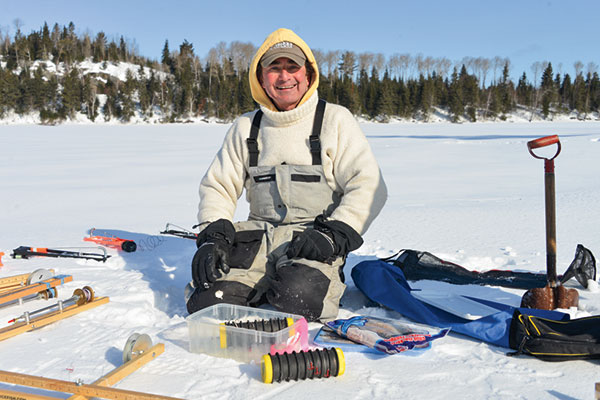
Dr. John Casselman, a former colleague and former Senior Research Scientist with the Ontario Ministry of Natural Resources says, "Pike in winter are poorly understood. We know less about what they do then than any other time of year. But the more we learn about them, the more fascinating they become. What pike do in winter is much more impressive than what they do in summer."
LESSON 2: Take Their Temperature
According to Casselman, winter pike-fishing success is influenced by the temperature of the water, the amount of dissolved oxygen it holds, and the amount of light streaming through it. This surprises many anglers who gaze out over a frozen surface and see nothing but a void of cold, dark water. It's anything but that.
You won't find water temperatures in winter that approach optimal temperatures for pike, but you do find water temperatures that can vary considerably. That's why I typically target Canadian Shield-type lakes at first ice, as soon as I can safely get out on them, and fish around moderately deep (20- to 30-foot) rock structures that most anglers would associate with winter walleyes, yellow perch, whitefish, and tulibees.
I was originally targeting these other species when I discovered this early-season pike pattern. I reckoned the big toothy critters were eating the other species, and still believe that to be the case. But things fell into place when I lowered an underwater camera equipped with a temperature sensor. It read 40°F close to the bottom and near freezing (32.9°F) just under the ice and in the shallows. That's a big difference to a cold-blooded animal that regulates its body temperature and activity level by swimming into warmer or cooler water.
It also helped explain why the late-winter ice period can be spectacular. Find a creek, stream, or river flowing into a shallow, weedy, bay or cove in late March and early April and you discover amazingly tepid water and prodigious pike. The inflow is the hot water tap filling up the bathtub and the pike are your toes searching for the warmth.
LESSON 3: A Eureka Moment
Take two otherwise similar lakes and the one with the clearest water is the winter pike winner almost every time. Ditto, if you ice-fish a large waterbody like Rainy Lake or Lake of the Woods. The clear-water sections typically excel.
I'll never forget connecting these dots and then listening to Casselman explain how he could regulate the activity level of pike in the laboratory with the twist of the dimmer switch controlling the lights. When he set the level between 300 and 700 lux, pike immediately became active.
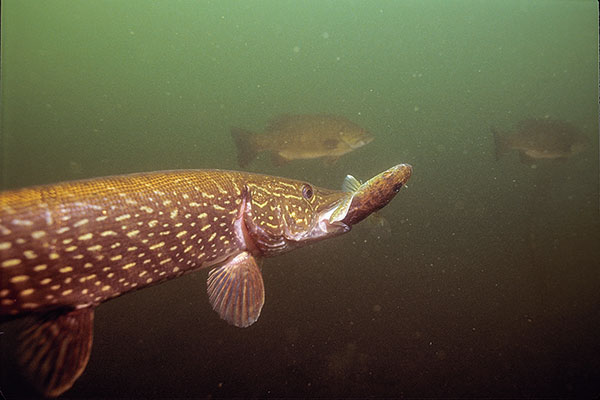
He could cause the pike to rise up from the bottom and become immediate visual predators, in a Pavlov's dog type of response, the instant he adjusted light level. He could just as quickly put the fish to sleep by darkening the room.
I have a favorite pike lake I fish during the open-water season that's tannic-stained. For years, it's fascinated me in winter, especially since the day I spotted my tip-up flag fly and ran out to grab it. A pike was pulling out line so quickly and with such incredible force, the entire tip-up was bouncing up and down in the hole.
When I felt the line streaming out between my fingers, it was as though I'd hooked a train. I've landed pike in the 52- to 54-inch (30- to 32-pound class), but this fish was much bigger. When I tightened up on the line to set the hooks, they popped out.
Looking back on that day on the stained-water lake, and the relatively few others when I was successful there, I realized the sun was always shining brightly and there was never a time when deep snow blanketed the thick ice. It was a eureka moment as far as how light levels affect pike activity.
LESSON 4: The Dead Sea
Living in Northwest Ontario amidst pike-rich waters, you may be surprised that one of my favorite winter fisheries is a moderate-size lake with crystal-clear water that receives heavy fishing pressure during the open-water season. Most locals refer to it as the "Dead Sea." I like that moniker because it dissuades winter claim jumpers.
What I've learned from the Dead Sea is that while these lakes may be "fished down," they're never "fished out." More importantly, pike are survivors, especially big ones. While heavy fishing pressure during open water often removes a significant amount of biomass, it tends to be focused on small to moderate-size fish. The survivors have less competition for an expanding forage base, so they grow big quickly. I'm not saying ice fishing there is easy, because it's not. But, if you don't draw attention to yourself and hit the Dead Seas under ideal conditions—first ice, last ice, during mid-week, ideal weather conditions—and set up around the best locations, you can enjoy pike fishing that rivals the best fly-in experiences.
LESSON 5: Get Out Of The Weeds
The two biggest mistakes pike anglers make are assuming pike are always in vegetation and forgetting that seasonal patterns evolve. Case in point: Late fall is a period of consolidation when pike move away from deep weededges they've been frequenting throughout the summer and set up around main-lake shoals and points that break into deep water. If there's an associated ledge or feeding flat in the 10- to 20-foot depth range, so much the better.
This migration typically has nothing to do with decaying vegetation or a decline in oxygen. Instead, it's related to pike following prey—white suckers, yellow perch, and walleyes—to their late-fall and winter haunts. In late fall, big pike set up to intercept and ambush hordes of tulibees and whitefish that are shifting toward shallow rock shoals to spawn.
You may have experienced the almost non-stop big-fish action in late fall that rockpiles can produce, so why not start the ice-fishing season around these same structures? Why go back to shallow weedy bays after enjoying such good action? The transition between the fall period of consolidation and first ice is a natural ebb and flow. A process that often continues well after ice covers the lake. It's the reason why, as I mentioned earlier, deep, main-lake rock structures are typically the best locations to start fishing when safe travel is guaranteed.
LESSON 6: Get Chummy With Pike
If British angler Nigel Williams learns that someone has spotted a big pike, he says he'll catch it. Known as the Bounty Hunter for his relentless pursuit of individual fish, he's landed 165 pike over 20 pounds, 21 over 30 pounds, and two that topped 40.
He says two ingredients have contributed to his success. The first is an almost exclusive reliance on big live- and deadbaits presented on quick-strike rigs. He's caught only two pike over 30 pounds on lures. The second secret is pre-baiting your fishing locations. "Few fish respond better than pike to pre-baiting tactics," Williams says. "I can get them to eat hot dogs." According to Williams, the key to correctly chumming a location is doling out small chunks of food—suckers and tulibees are the ideal candidates across the ice belt—in a small steady stream over several days rather than one larger effort.
He says big pike are so "programmable" that you have to match your chumming to coincide with your fishing time. "A mistake many pike anglers make is they pre-bait a spot in the afternoon for several days, on their way home from work," he says. "Then, they arrive on Saturday morning to fish it but pike aren't there yet. When you fish a spot at the same time you pre-baited it, you'll find the pike waiting for you."
Word of caution: Check regulations where you fish to determine if chumming or pre-baiting is legal. In Minnesota for example, it's illegal. Check before you chum.
Lesson 7: Follow the Slush
There's nothing I hate more than wading through knee-deep slush. But, if you fish shallow, weedy pike lakes, especially lakes those prone to winterkill, slush can be a godsend.
Casselman confirmed the "slush pattern" many years ago and it's saved the day for me many times. But it depends on what caused the slush. The weight of deep snow pushing down on the ice often cracks it, causing water to stream up through the fractures and mix with the snow on the surface. But this kind of slush doesn't cut it.
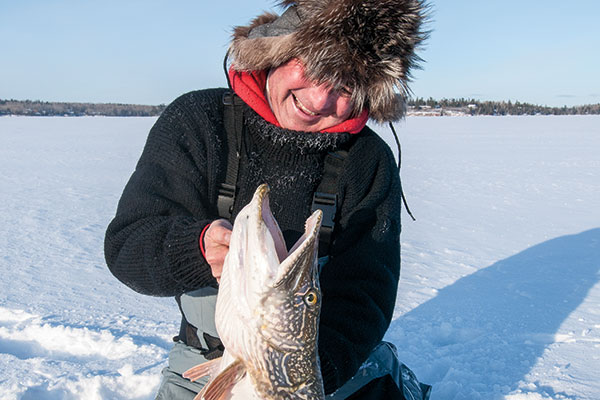
What's needed are midwinter thaws, especially accompanied by rain. Standing water on the surface eventually finds a crack in the ice through which to drain, or it honeycombs the ice and filters down into the lake, giving pike a blast of oxygen in an otherwise depleted environment.
If you don't think pike can find it, consider that Casselman once placed a 200-foot-long test net in a shallow lake and caught over 300 pike crammed into a small area along the northeast shoreline that was receiving the bulk of the mid-winter sun. So many pike were in the net that virtually every mesh contained a fish. We have so many more winter pike lessons to learn.
*In-Fisherman Field Editor Gord Pyzer lives in Kenora, Ontario, and is a former Ontario resource manager.

